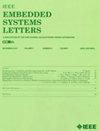Hiding in Plain Sight: Reframing Hardware Trojan Benchmarking as a Hide&Seek Modification
IF 1.7
4区 计算机科学
Q3 COMPUTER SCIENCE, HARDWARE & ARCHITECTURE
引用次数: 0
Abstract
This letter focuses on advancing security research in the hardware design space by formally defining the realistic problem of hardware Trojan (HT) detection. The goal is to model HT detection more closely to the real world, i.e., describing the problem as “The Seeker’s Dilemma” where a detecting agent is unaware of whether circuits are infected by HTs or not. Using this theoretical problem formulation, we create a benchmark that consists of a mixture of HT-free and HT-infected restructured circuits while preserving their original functionalities. The restructured circuits are randomly infected by HTs, causing a situation where the defender is uncertain if a circuit is infected or not. We believe that our innovative benchmark and methodology of creating benchmarks will help the community judge the detection quality of different methods by comparing their success rates in circuit classification. We use our developed benchmark to evaluate three state-of-the-art HT detection tools to show baseline results for this approach. We use principal component analysis to assess the strength of our benchmark, where we observe that some restructured HT-infected circuits are mapped closely to HT-free circuits, leading to significant label misclassification by detectors.隐藏在显而易见的地方:重新构建硬件木马基准测试作为一个捉迷藏的修改
这封信的重点是通过正式定义硬件木马(HT)检测的现实问题来推进硬件设计领域的安全研究。目标是建立更接近现实世界的高温感应检测模型,也就是说,将这个问题描述为“探索者的困境”,即检测代理不知道电路是否被高温感应感染。使用这一理论问题公式,我们创建了一个基准,该基准由无ht和受ht感染的重组电路混合组成,同时保留了其原始功能。重组后的电路被随机感染,导致防御者不确定电路是否被感染。我们相信我们的创新基准和创建基准的方法将有助于社区通过比较不同方法在电路分类中的成功率来判断不同方法的检测质量。我们使用我们开发的基准来评估三种最先进的高温检测工具,以显示该方法的基线结果。我们使用主成分分析来评估我们的基准的强度,我们观察到一些重组的ht感染电路与无ht电路密切相关,导致检测器严重的标签错误分类。
本文章由计算机程序翻译,如有差异,请以英文原文为准。
求助全文
约1分钟内获得全文
求助全文
来源期刊

IEEE Embedded Systems Letters
Engineering-Control and Systems Engineering
CiteScore
3.30
自引率
0.00%
发文量
65
期刊介绍:
The IEEE Embedded Systems Letters (ESL), provides a forum for rapid dissemination of latest technical advances in embedded systems and related areas in embedded software. The emphasis is on models, methods, and tools that ensure secure, correct, efficient and robust design of embedded systems and their applications.
 求助内容:
求助内容: 应助结果提醒方式:
应助结果提醒方式:


